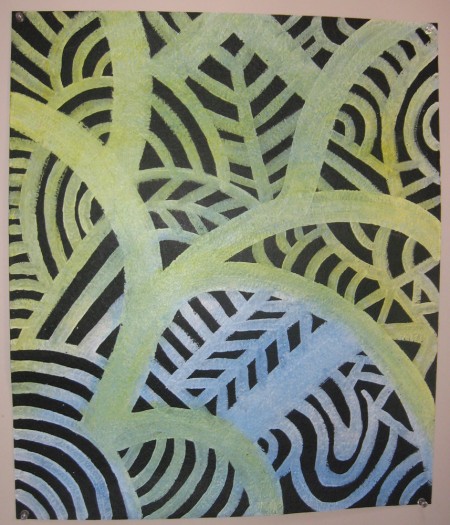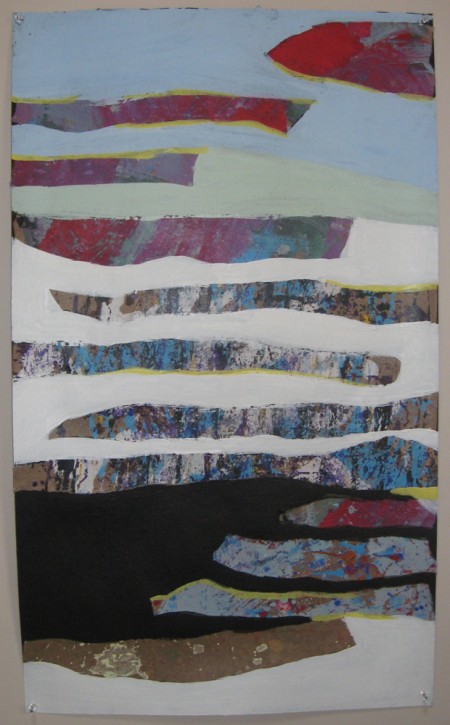What I learned from abstract painting class, part 3
I've been blogging about what I learned about writing from an abstract painting class I took recently. Take a look at part 1 and part 2. In the fourth class we learned how to work with glazes. A glaze is basically a small amount of color mixed into a large amount of matte (or gloss) medium. When it's painted over something, it creates a sort of shiny, transparent finish. Our teacher explained that if you want to change something about a painting, but you don't want to change too much of it, you can apply a glaze.
So, on to the exercise. First we were given blank sheets of tarpaper (the stuff they use for roofing), and were instructed to paint only white lines that were no more than 1 inch apart. After that, I mixed a couple of glazes, using drops of yellow and blue, and glazed the white-on-black lines. Here's what came of it:
The white lines I initially painted reminded me a lot of trees. This is why I mixed the yellow and blue glazes — to make green. Hey, I remembered something from elementary school art class!
I wasn't sure what to think about this one. The glazing effect seems a little bit too light for me. I want it to be more dramatic! On the other hand, an interesting thing happened during the painting of the lines. I was so involved with painting the lines, 1 inch apart, that I had no idea what image would emerge at the end. When I had covered the whole thing with lines and stepped back (perspective!), I was really amazed to see what looked like a tree.
I missed the fifth week of class because I finally succumbed to the cold that was going around, but I did return for the last class, in which we worked with collage.
I did a lot of collage when I was an angsty teenager. I remember tearing lots of things out of magazines and happily assembling them into wordy posters that I thought were very cool. As an adult, they're a bit painful for me to look at because it's so clear that I was lonely and barraged with emotions I didn't understand. So, working with collage was a bit strange for me. It brought back a lot of difficult feelings, and perhaps that's why I wasn't too keen on doing it.
During the class we did several exercises that involved collaging very rapidly, then passing the paintings on to other class members to re-collage. I didn't really understand this. By the time we got to the last exercise of the night, I probably was a bit frustrated.
However, I did find some interesting paint-spattered paper that I collaged onto tarpaper in strips, and then I painted around the spaces. Here's the finished product:
I started painting this one horizontally, but it made a lot more sense to me when I rotated it into a vertical rectangle. I feel like there's a sense of journey in it, moving from bottom to top again, like the Huntress painting.
It might be appropriate that I ended the class with this painting, because I feel like I'm at the very beginning of a journey here. I still don't know much about painting, but now I have a lot of paint, and some ideas of things I could do. There are some images in my head from a book I'm thinking about writing, and I really want to paint them. There's a lot of orange in these images, and I'd like to begin by painting a bunch of orange squares. I realize this sounds bizarre, but hey, I'm letting myself do whatever with this! I want to keep painting as a fun thing — playtime, you know.
I find that as I develop as a writer, I'm less and less likely to just play with words in the way I did as a teenager. Writing has been a job for me for several years now, and sometimes it's a good idea to remind myself that being creative is about more than figuring out the best word to use in a sentence. That's good too, but painting seems to be so open and unbounded to me. There's no grammar! There's no spelling! And yet it does allow me to write, in a way, with images.
All I need now is a drop cloth and some room to make a mess.

